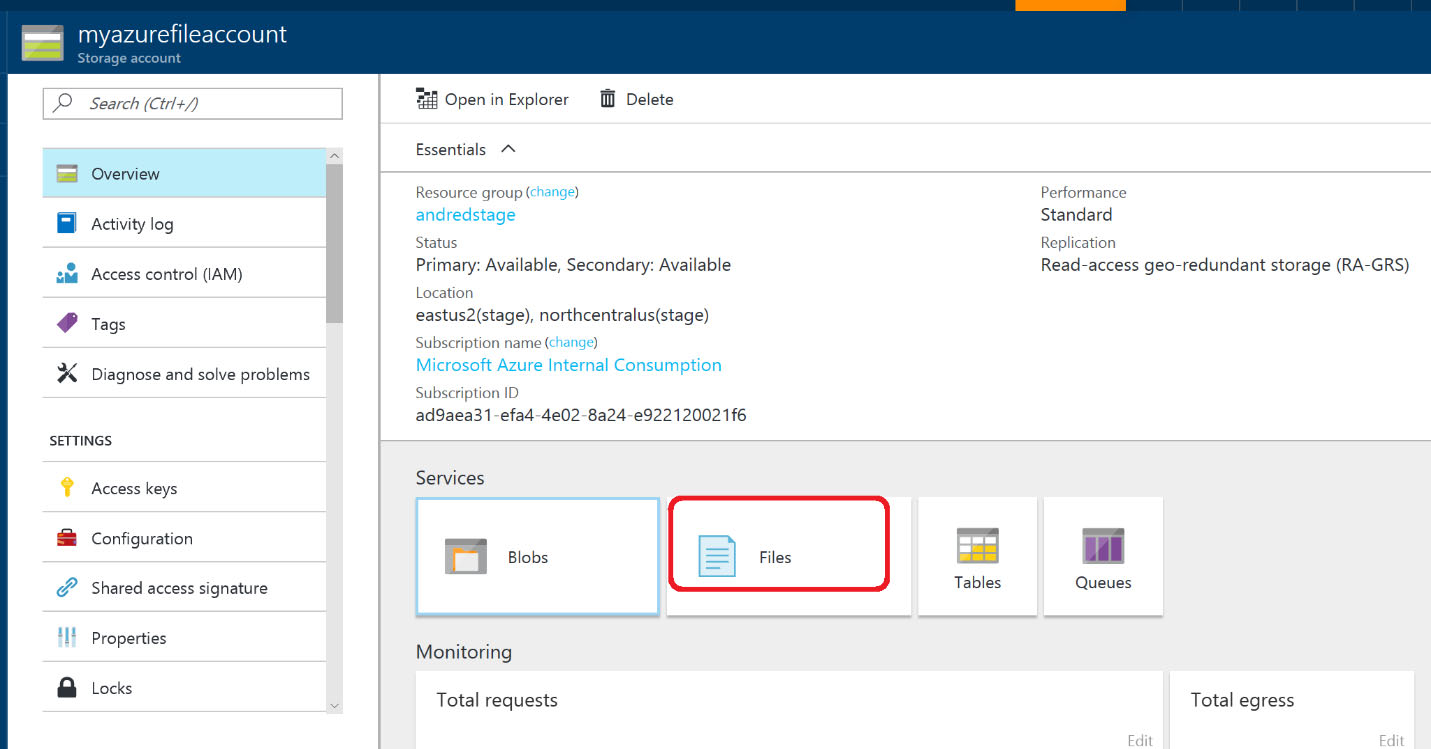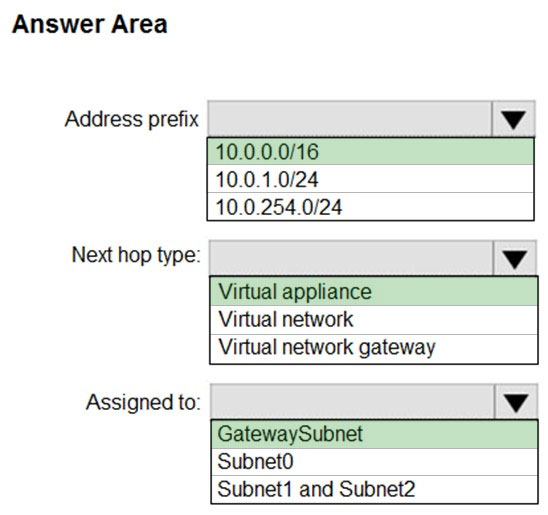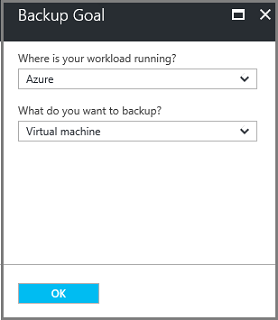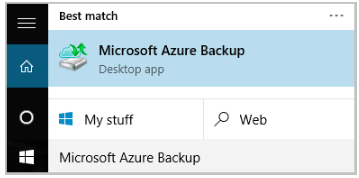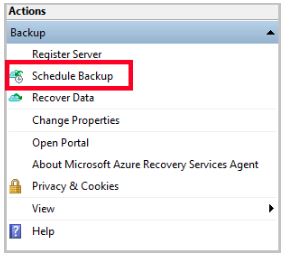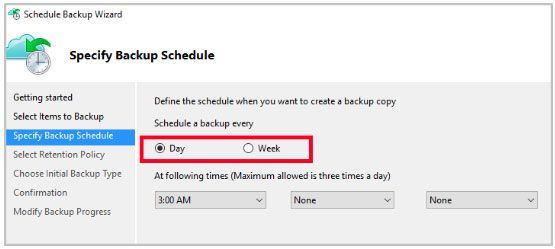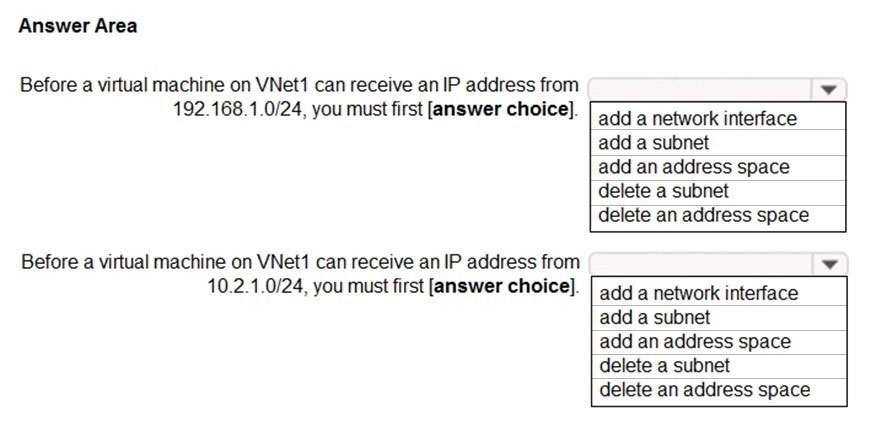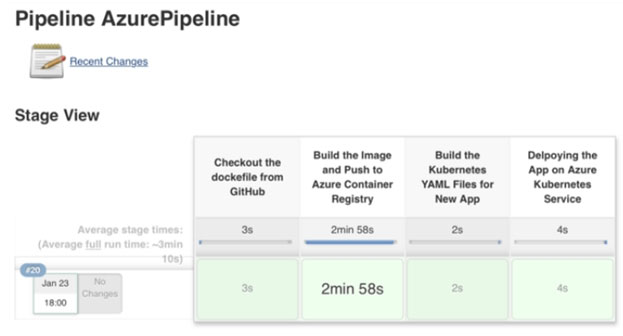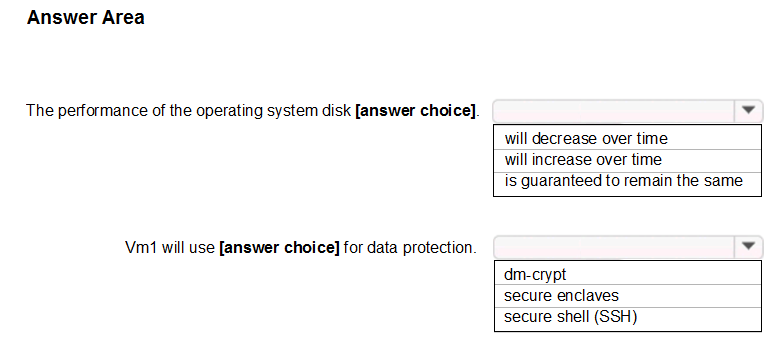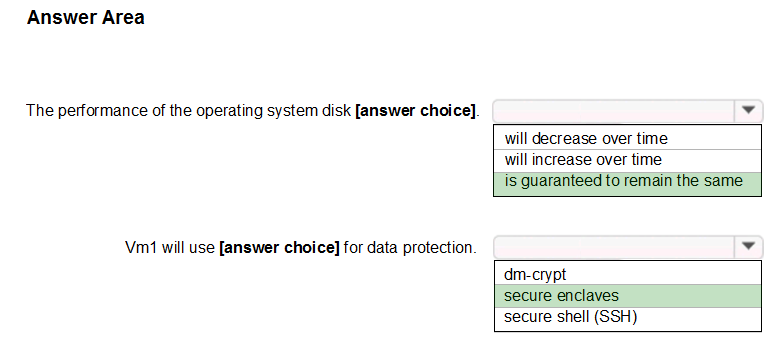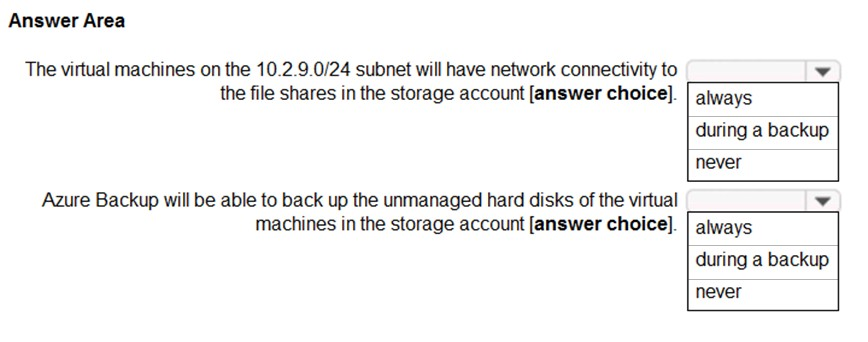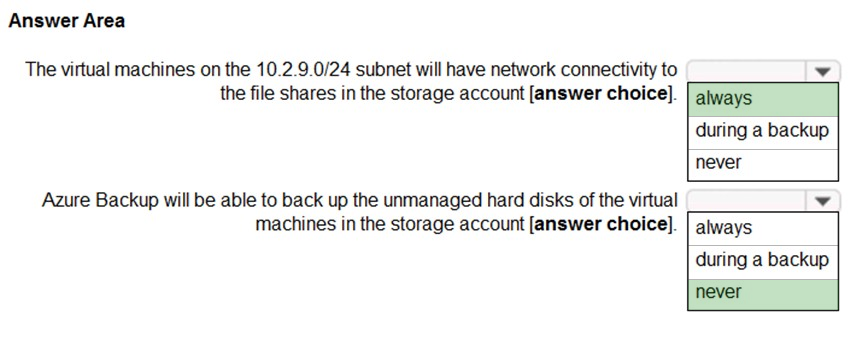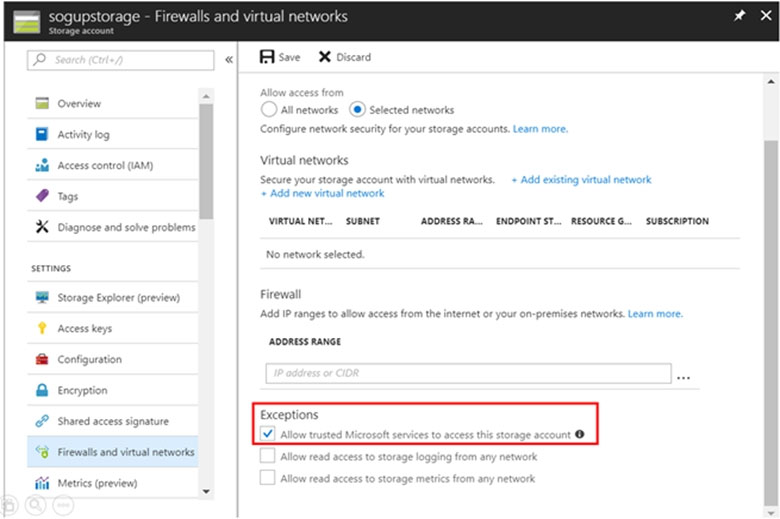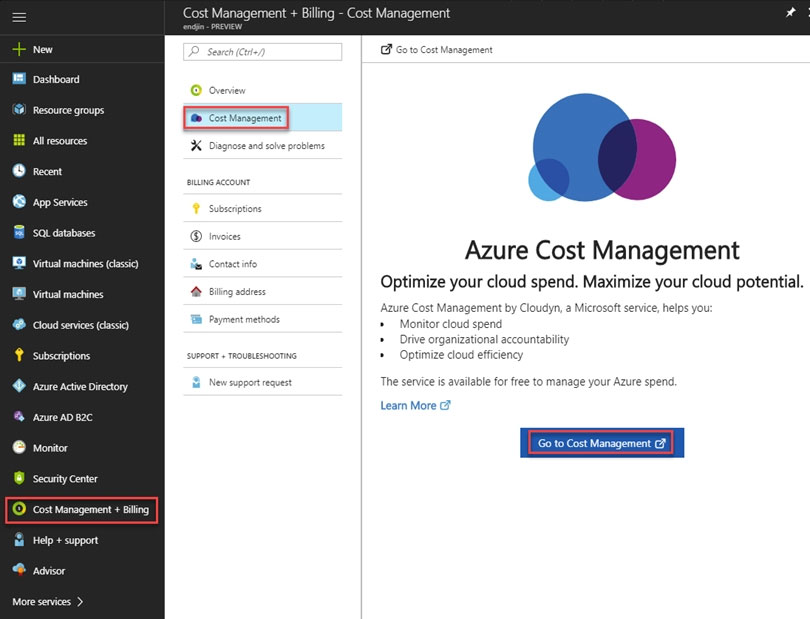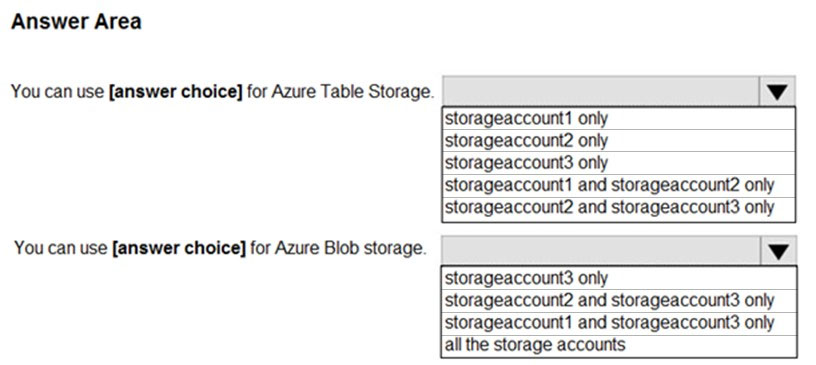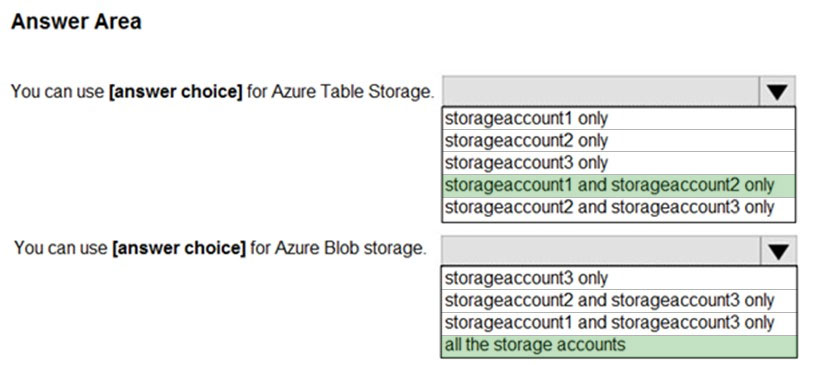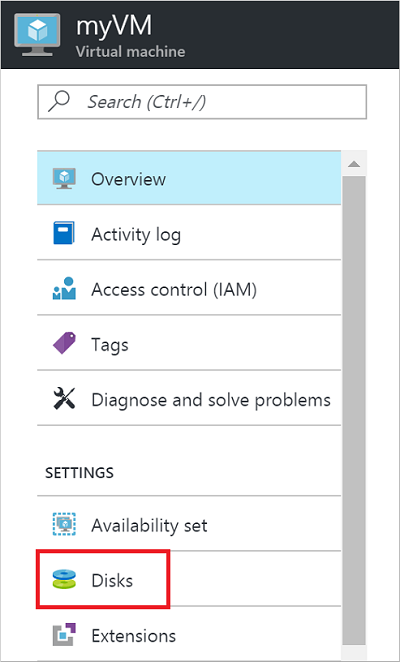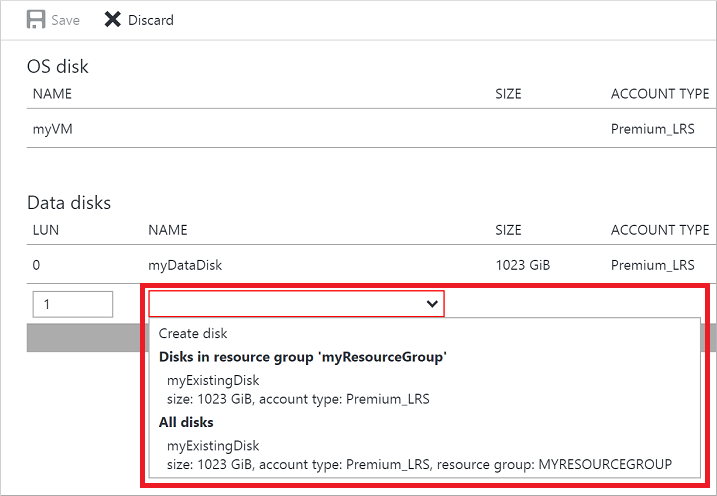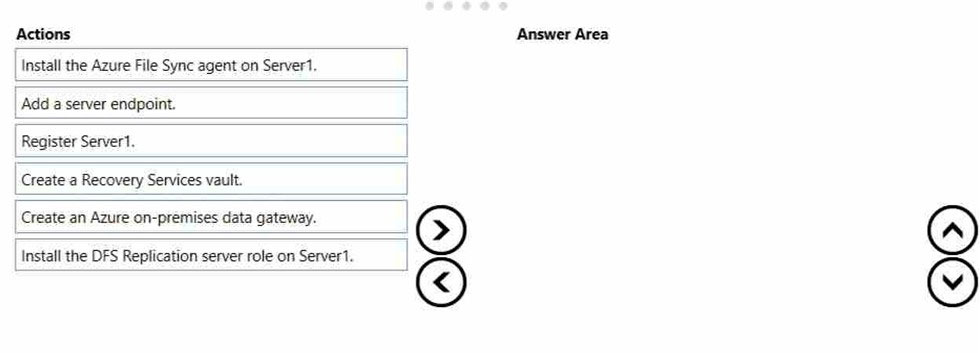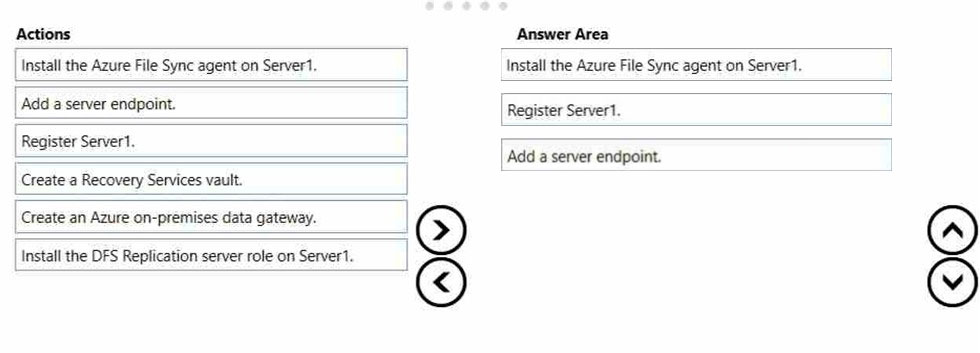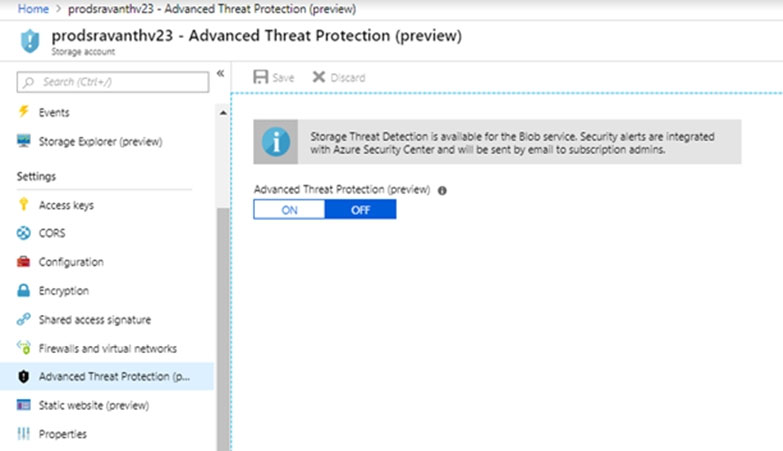AZ-303 Practice Exam Free – 50 Questions to Simulate the Real Exam
Are you getting ready for the AZ-303 certification? Take your preparation to the next level with our AZ-303 Practice Exam Free – a carefully designed set of 50 realistic exam-style questions to help you evaluate your knowledge and boost your confidence.
Using a AZ-303 practice exam free is one of the best ways to:
- Experience the format and difficulty of the real exam
- Identify your strengths and focus on weak areas
- Improve your test-taking speed and accuracy
Below, you will find 50 realistic AZ-303 practice exam free questions covering key exam topics. Each question reflects the structure and challenge of the actual exam.
You have an Azure subscription that contains the storage accounts shown in the following table.All storage accounts contain blobs only. You need to implement several lifecycle management rules for all storage accounts. What should you do first?
A. Upgrade contosostorage1 and contosostorage2 to General Purpose V2 accounts.
B. Move 5 TB of blob data from contosostorage3 to contosostorage4.
C. Move 5 TB of blob data from contosostorage1 to contosostorage2.
D. Recreate contosostorage5 as a General Purpose V2 account.
You have the following Azure Active Directory (Azure AD) tenants: ✑ Contoso.onmicrosoft.com: Linked to a Microsoft 365 tenant and syncs to an Active Directory forest named contoso.com by using password hash synchronization ✑ Contosoazure.onmicrosoft.com: Linked to an Azure subscription named Subscription1 You need to ensure that you can assign the users in contoso.com access to the resources in Subscription1. What should you do?
A. Associate Subscription1 to contoso.onmicrosoft.com. Reassign all the roles in Subscription1.
B. Configure the existing Azure AD Connect server to sync contoso.com to contosoazure.onmicrosoft.com.
C. Configure contoso.onmicrosoft.com to use pass-through authentication.
D. Configure contosoazure.onmicrosoft.com to use pass-through authentication.
You create a new Azure subscription. You create a resource group named RG1. In RG1, you create the resources shown in the following table.You need to configure an encrypted tunnel between your on-premises network and VNET1. Which two additional resources should you create in Azure? Each correct answer presents part of the solution. NOTE: Each correct selection is worth one point.
A. a site-to-site connection
B. a VPN gateway
C. a VNet-to- VNet connection
D. a local network gateway
E. a point-to-site configuration
You develop an entertainment application where users can buy and trade virtual real estate. The application must scale to support thousands of users. The current architecture includes five Azure virtual machines (VM) that connect to an Azure SQL Database for account information and Azure Table Storage for backend services. A user interacts with these components in the cloud at any given time. ✑ Routing Service `" Routes a request to the appropriate service and must not persist data across sessions. ✑ Account Service `" Stores and manages all account information and authentication and requires data to persist across sessions ✑ User Service `" Stores and manages all user information and requires data to persist across sessions. ✑ Housing Network Service `" Stores and manages the current real-estate economy and requires data to persist across sessions. Trade Service `" Stores and manages virtual trade between accounts and requires data to persist across sessions.Due to volatile user traffic, a microservices solution is selected for scale agility. You need to migrate to a distributed microservices solution on Azure Service Fabric. Solution: Create a Service Fabric Cluster with a stateless Reliable Service for Routing Service. Create stateful Reliable Services for all other components. Does the solution meet the goal?
A. Yes
B. No
You have an Azure subscription that contains an Azure Service Fabric cluster and a Service Fabric application named FabricApp. You develop and package a Service Fabric application named AppPackage. AppPackage is saved in a compressed folder named AppPackage.zip. You upload AppPackage.zip to an external store. You need to register AppPackage in the Azure subscription. What should you do first?
A. Run the New-ServiceFabricApplication cmdlet.
B. Repackage the application in a file named App.sfpkg.
C. Create a new Service Fabric cluster.
D. Copy AppPackage.zip to a blob storage account.
You create a new Azure subscription. You create a resource group named RG1. In RG1, you create the resources shown in the following table.You need to configure an encrypted tunnel between your on-premises network and VNET1. Which two additional resources should you create in Azure? Each correct answer presents part of the solution. NOTE: Each correct selection is worth one point.
A. a VPN gateway
B. a site-to-site connection
C. a point-to-site configuration
D. a VNet-to-VNet connection
E. a local network gateway
You have an Azure subscription that contains a resource group named RG1. RG1 contains 100 virtual machines. Your company has three cost centers named Manufacturing, Sales, and Finance. You need to associate each virtual machine to a specific cost center. What should you do?
A. Add an extension to the virtual machines
B. Modify the inventory settings of the virtual machine
C. Assign tags to the virtual machines
D. Configure locks for the virtual machine
SIMULATION - Click to expand each objective. To connect to the Azure portal, type https://portal.azure.com in the browser address bar.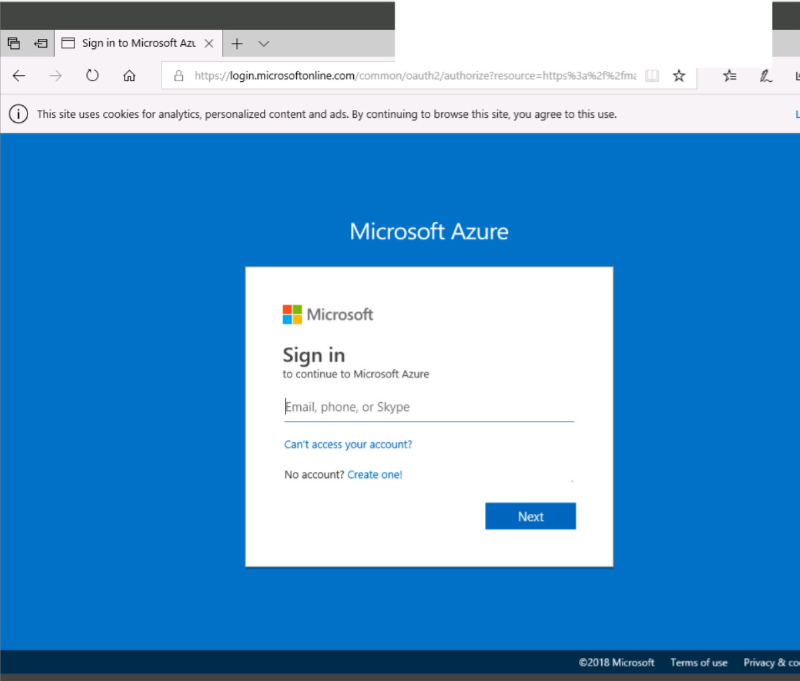
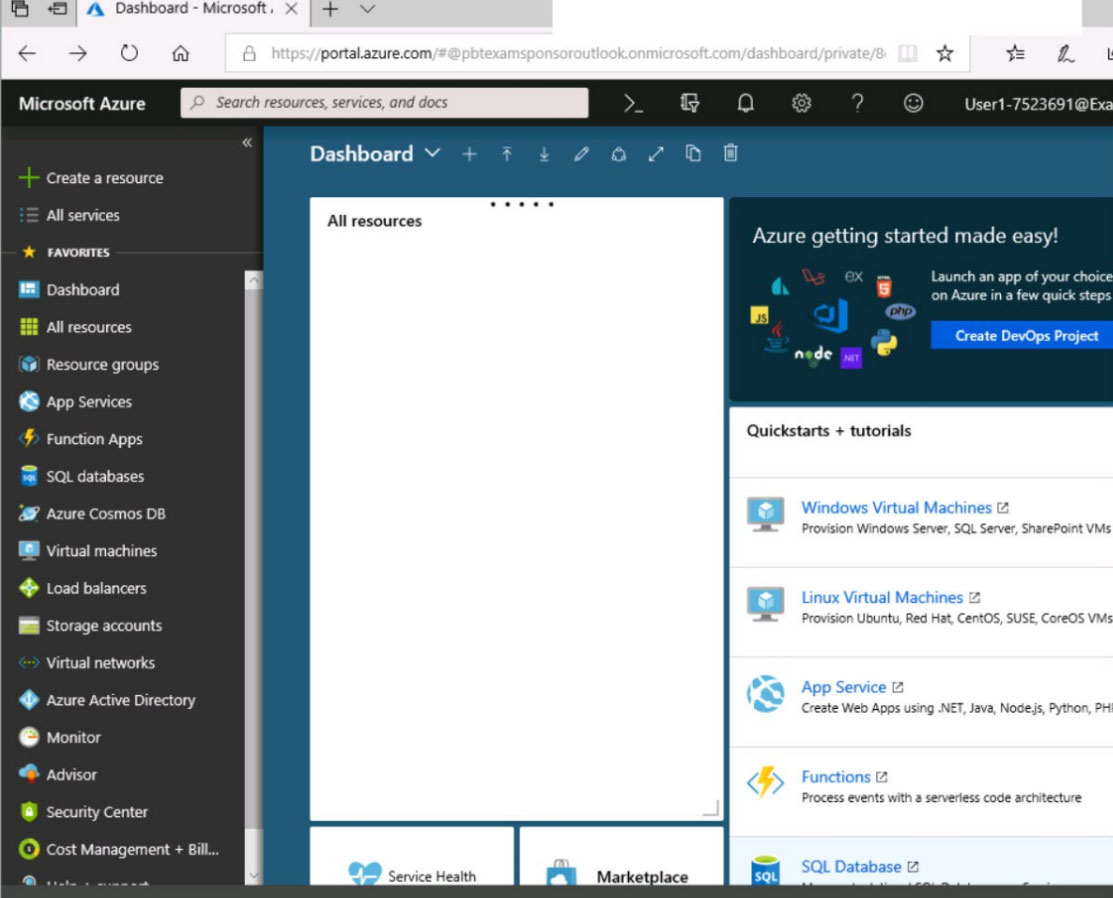
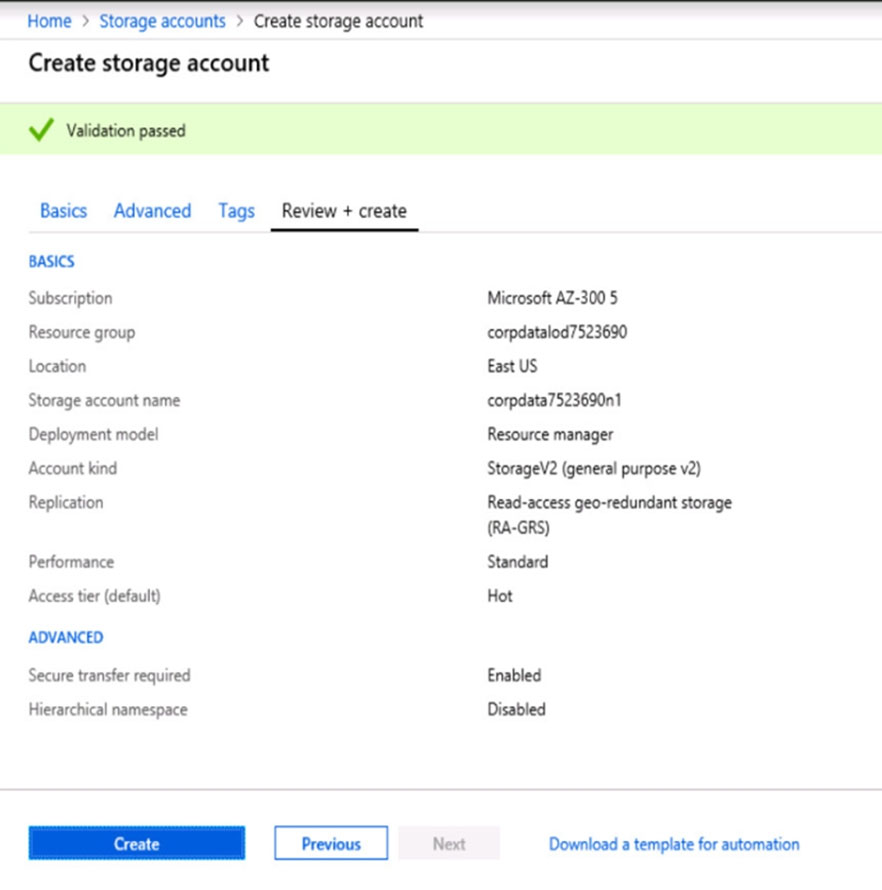
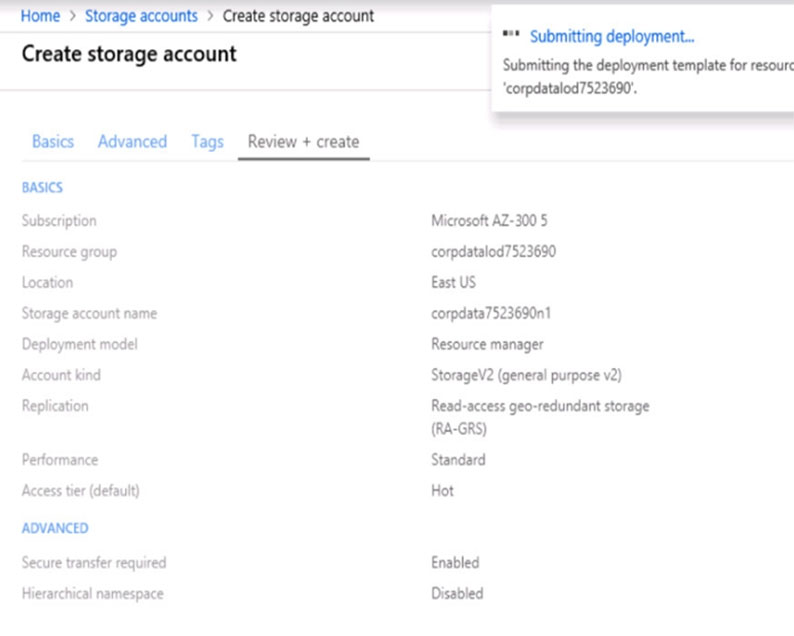
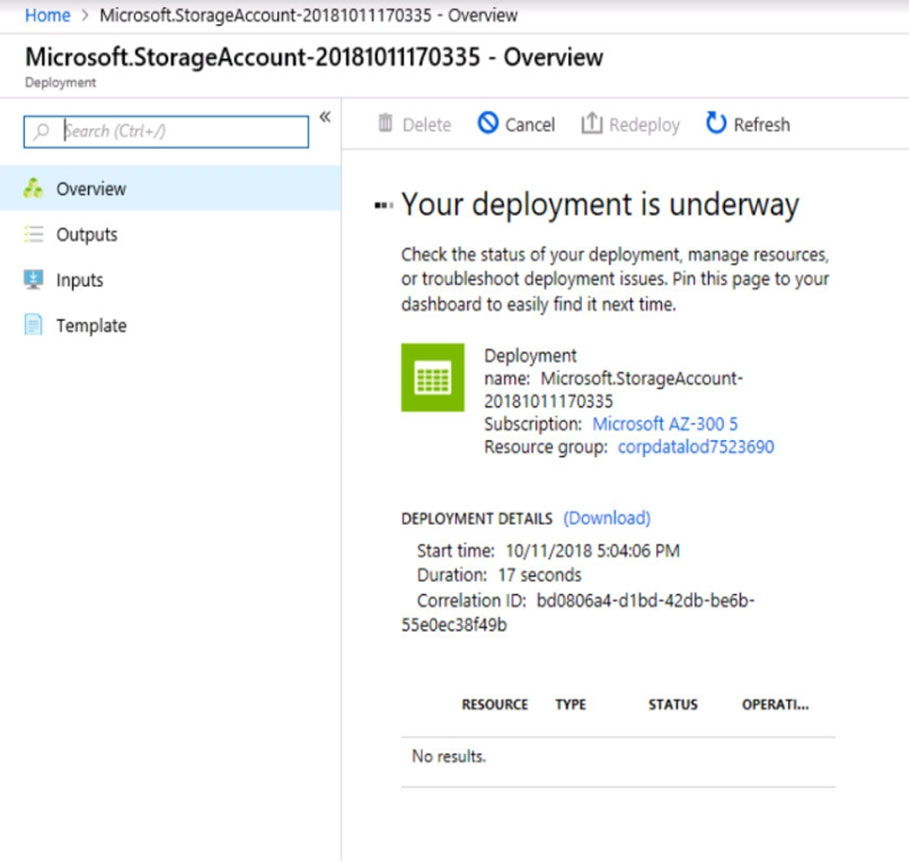
When you are finished performing all the tasks, click the `˜Next' button. Note that you cannot return to the lab once you click the `˜Next' button. Scoring occur in the background while you complete the rest of the exam. Overview - The following section of the exam is a lab. In this section, you will perform a set of tasks in a live environment. While most functionality will be available to you as it would be in a live environment, some functionality (e.g., copy and paste, ability to navigate to external websites) will not be possible by design. Scoring is based on the outcome of performing the tasks stated in the lab. In other words, it doesn't matter how you accomplish the task, if you successfully perform it, you will earn credit for that task. Labs are not timed separately, and this exam may have more than one lab that you must complete. You can use as much time as you would like to complete each lab. But, you should manage your time appropriately to ensure that you are able to complete the lab(s) and all other sections of the exam in the time provided. Please note that once you submit your work by clicking the Next button within a lab, you will NOT be able to return to the lab. To start the lab - You may start the lab by clicking the Next button. Your company plans to host in Azure the source files of several line-of-business applications. You need to create an Azure file share named corpsoftware in the corpdata7523690n1 storage account. The solution must ensure that corpsoftware can store only up to 250 GB of data. What should you do from the Azure portal?
Note: This question is part of series of questions that present the same scenario. Each question in the series contains a unique solution that might meet the stated goals. Some question sets might have more than one correct solution, while others might not have a correct solution. After you answer a question in this section, you will NOT be able to return to it. As a result, these questions will not appear in the review screen. You are planning to create a virtual network that has a scale set that contains six virtual machines (VMs). A monitoring solution on a different network will need access to the VMs inside the scale set. You need to define public access to the VMs. Solution: Use Remote Desktop Protocol (RDP) to connect to the VM in the scale set. Does the solution meet the goal?
A. Yes
B. No
You have an Azure subscription named Subscription1 that contains an Azure virtual network named VNet1. VNet1 connects to your on-premises network by using Azure ExpressRoute. You need to connect VNet1 to the on-premises network by using a site-to-site VPN. The solution must minimize cost. Which three actions should you perform? Each correct answer presents part of the solution. NOTE: Each correct selection is worth one point.
A. Create a gateway subnet.
B. Create a VPN gateway that uses the VpnGw1 SKU.
C. Create a connection.
D. Create a local site VPN gateway.
E. Create a VPN gateway that uses the Basic SKU.
Your on-premises network contains several Hyper-V hosts. You have a hybrid deployment of Azure Active Directory (Azure AD). You create an Azure Migrate project. You need to ensure that you can evaluate virtual machines by using Azure Migrate. Which two actions should you perform? Each correct answer presents part of the solution. NOTE: Each correct selection is worth one point.
A. Deploy the Azure Migrate appliance to an on-premises Hyper-V host.
B. Assign the migration account to the Administrators group on each Hyper-V virtual machine.
C. Deploy the Microsoft Monitoring Agent to each Hyper-V host.
D. Assign the migration account to the Administrators group on each Hyper-V host.
E. Deploy the Microsoft Monitoring Agent to each Hyper-V virtual machine.
F. Deploy the Azure Migrate appliance as an Azure virtual machine.
Your company plans to develop an application that will use a NoSQL database. The database will be used to store transactions and customer information by using JSON documents. Which two Azure Cosmos DB APIs can developers use for the application? Each correct answer presents a complete solution. NOTE: Each correct selection is worth one point.
A. Gremlin (graph)
B. MongoDB
C. Cassandra
D. Core (SQL)
E. Azure Table
You are designing an Azure solution. The solution must meet the following requirements: Distribute traffic to different pools of dedicated virtual machines (VMs) based on rules Provide SSL offloading capabilities You need to recommend a solution to distribute network traffic. Which technology should you recommend?
A. server-level firewall rules
B. Azure Application Gateway
C. Azure Traffic Manager
D. Azure Load Balancer
After you answer a question in this section, you will NOT be able to return to it. As a result, these questions will not appear in the review screen. You have an Azure Cosmos DB database that contains a container named Container1. The partition key for Container1 is set to /day. Container1 contains the items shown in the following table.You need to programmatically query Azure Cosmos DB and retrieve Item1 and Item2 only. Solution: You run the following query. SELECT day - WHERE value = "10" You set the EnableCrossPartitionQuery property to False. Does this meet the goal?
A. Yes
B. No
You create an Azure virtual machine named VM1 in a resource group named RG1. You discover that VM1 performs slower than expected. You need to capture a network trace on VM1. What should you do?
A. From the VM1 blade, configure Connection troubleshoot.
B. From Diagnostic settings for VM1, configure the performance counters to include network counters.
C. From the VM1 blade, install performance diagnostics and run advanced performance analysis.
D. From Diagnostic settings for VM1, configure the log level of the diagnostic agent.
You have a resource group named RG1 that contains the following: ✑ A virtual network that contains two subnets named Subnet1 and AzureFirewallSubnet ✑ An Azure Storage account named contososa1 ✑ An Azure firewall deployed to AzureFirewallSubnet You need to ensure that contososa1 is accessible from Subnet1 over the Azure backbone network. What should you do?
A. Modify the Firewalls and virtual networks settings for contososa1.
B. Create a stored access policy for contososa1.
C. Implement a virtual network service endpoint.
D. Remove the Azure firewall.
HOTSPOT - You have Azure subscription that contains a virtual network named VNet1. VNet1 uses an IP address space of 10.0.0.0/16 and contains the subnets in the following table.Subnet1 contains a virtual appliance named VM1 that operates as a router. You create a routing table named RT1. You need to route all inbound traffic to VNet1 through VM1. How should you configure RT1? To answer, select the appropriate options in the answer area. NOTE: Each correct selection is worth one point. Hot Area:
You have an Azure subscription named Subscription1 that contains an Azure virtual machine named VM1. VM1 is in a resource group named RG1. VM1 runs services that will be used to deploy resources to RG1. You need to ensure that a service running on VM1 can manage the resources in RG1 by using the identity of VM1. What should you do first?
A. From the Azure portal, modify the Access control (IAM) settings of RG1.
B. From the Azure portal, modify the Policies settings of RG1.
C. From the Azure portal, modify the Access control (IAM) settings of VM1.
D. From the Azure portal, modify the value of the Managed Service Identity option for VM1.
You have a resource group named RG1 that contains the following: A virtual network that contains two subnets named Subnet1 and Subnet2 An Azure Storage account named contososa1 An Azure firewall deployed to Subnet2 You need to ensure that contososa1 is accessible from Subnet1 over the Azure backbone network. What should you do?
A. Deploy an Azure firewall to Subnet1.
B. Remove the Azure firewall.
C. Implement a virtual network service endpoint.
D. Create a stored access policy for contososa1.
You have an Azure subscription that contains the virtual networks shown in the following table.You need to recommend a connectivity solution that will enable the virtual machines on VNET1 and VNET2 to communicate through the Microsoft backbone infrastructure. What should you include in the recommendation?
A. Azure ExpressRoute
B. peering
C. a site-to-site VPN
D. a point-to-site VPN
You set the multi-factor authentication status for a user named admin1@contoso.com to Enabled. Admin1 accesses the Azure portal by using a web browser. Which additional security verifications can Admin1 use when accessing the Azure portal?
A. an app password, a text message that contains a verification code, and a verification code sent from the Microsoft Authenticator app
B. a phone call, a text message that contains a verification code, and a notification or a verification code sent from the Microsoft Authenticator app
C. a phone call, an email message that contains a verification code, and a text message that contains an app password
D. an app password, a text message that contains a verification code, and a notification sent from the Microsoft Authenticator app
HOTSPOT - You have an Azure subscription that contains multiple resource groups. You create an availability set as shown in the following exhibit.You deploy 10 virtual machines to AS1. Use the drop-down menus to select the answer choice that completes each statement based on the information presented in the graphic. NOTE: Each correct selection is worth one point. Hot Area:
You develop an entertainment application where users can buy and trade virtual real estate. The application must scale to support thousands of users. The current architecture includes five Azure virtual machines (VM) that connect to an Azure SQL Database for account information and Azure Table Storage for backend services. A user interacts with these components in the cloud at any given time. ✑ Routing Service `" Routes a request to the appropriate service and must not persist data across sessions. ✑ Account Service `" Stores and manages all account information and authentication and requires data to persist across sessions ✑ User Service `" Stores and manages all user information and requires data to persist across sessions. ✑ Housing Network Service `" Stores and manages the current real-estate economy and requires data to persist across sessions. ✑ Trade Service `" Stores and manages virtual trade between accounts and requires data to persist across sessions. Due to volatile user traffic, a microservices solution is selected for scale agility. You need to migrate to a distributed microservices solution on Azure Service Fabric. Solution: Create a Service Fabric Cluster with a stateful Reliable Service for Routing Service. Deploy a Guest Executable to Service Fabric for each component. Does the solution meet the goal?
A. Yes
B. No
You have an Azure subscription. You create a custom role in Azure by using the following Azure Resource Manager template.You assign the role to a user named User1. Which action can User1 perform?
A. Create virtual machines.
B. Create resource groups.
C. Delete virtual machines.
D. Create support requests.
SIMULATION - Click to expand each objective. To connect to the Azure portal, type https://portal.azure.com in the browser address bar.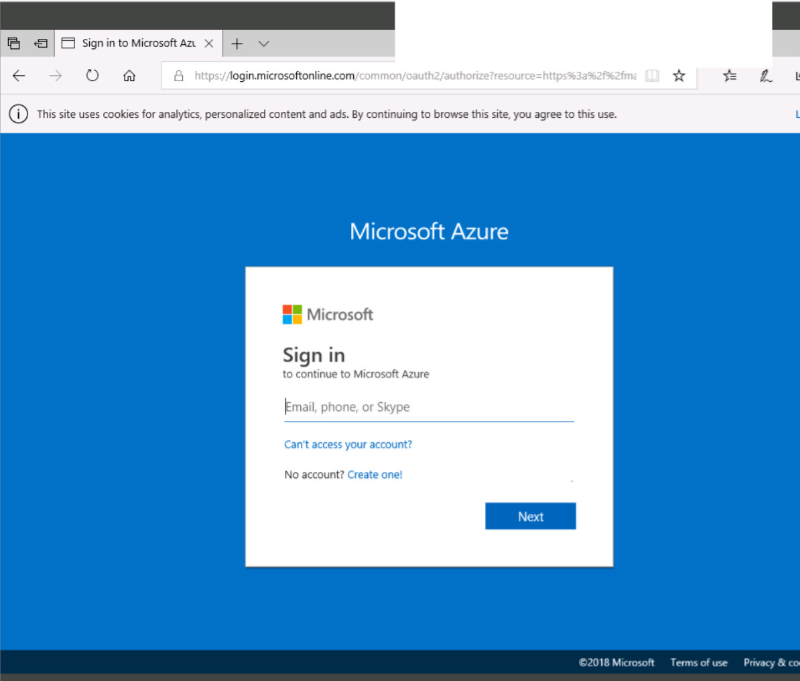
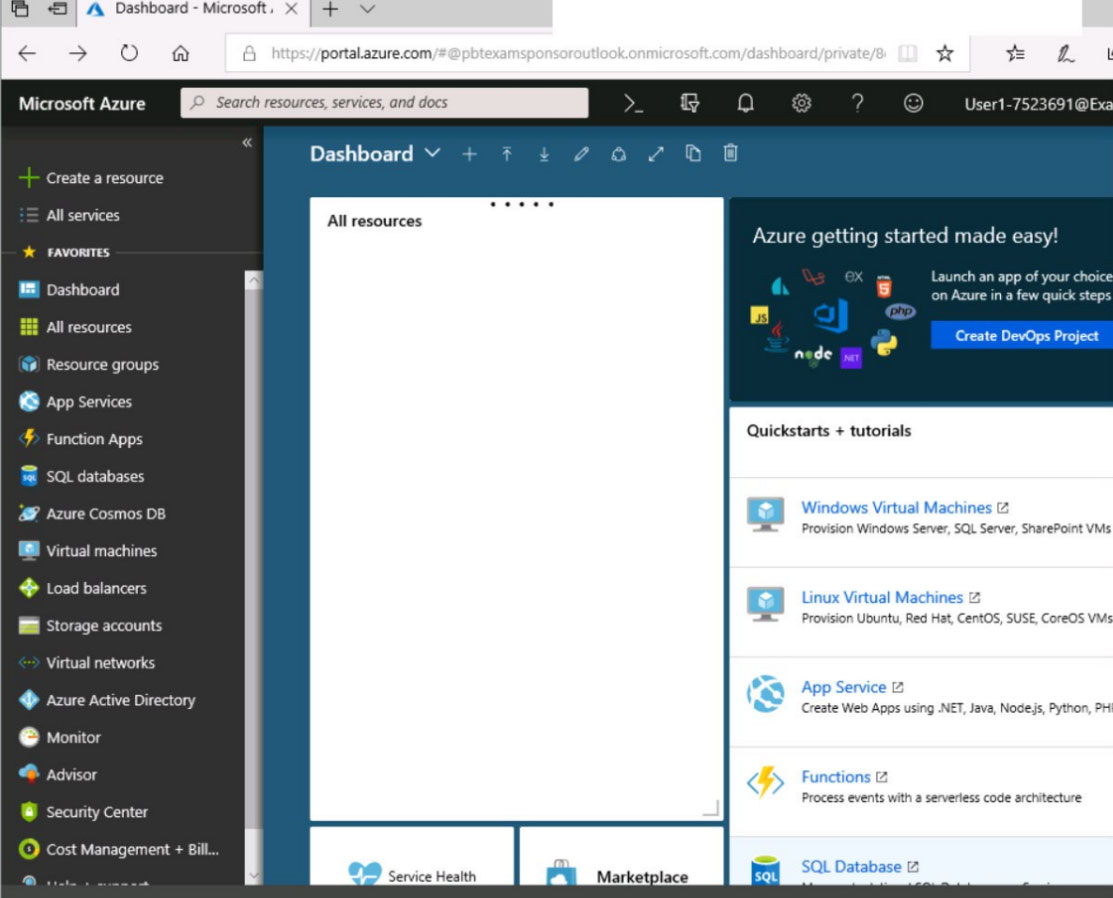
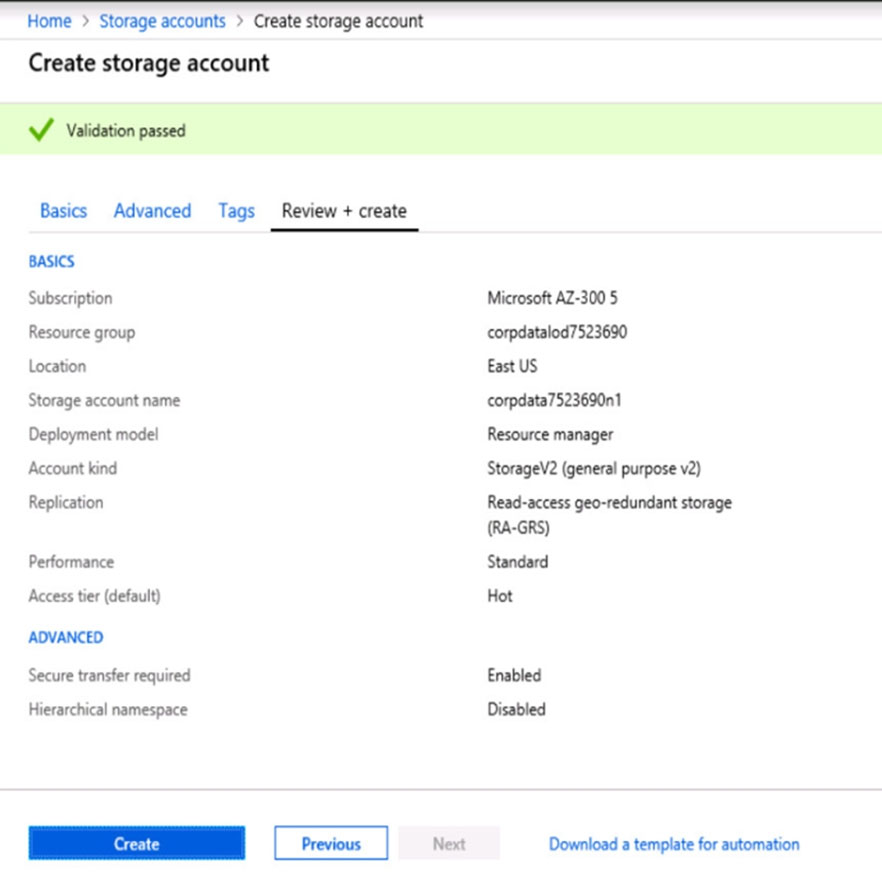
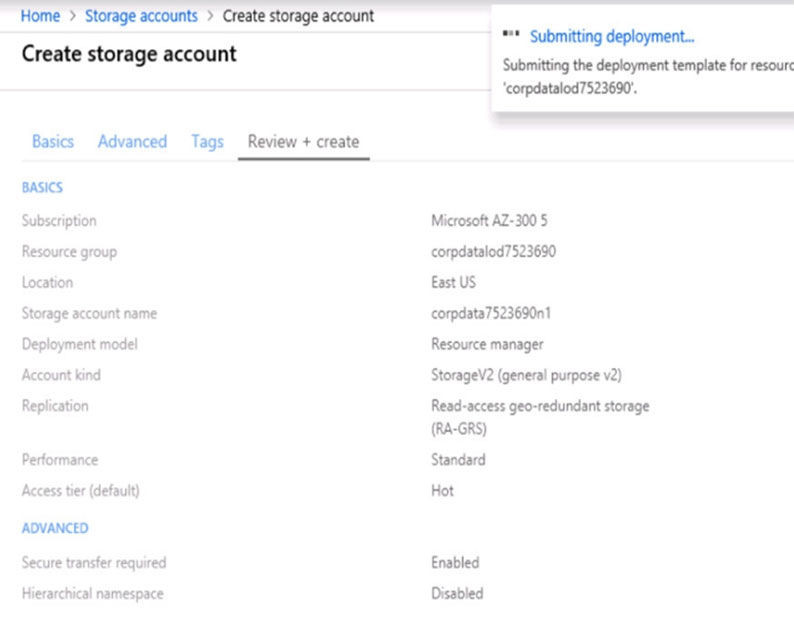
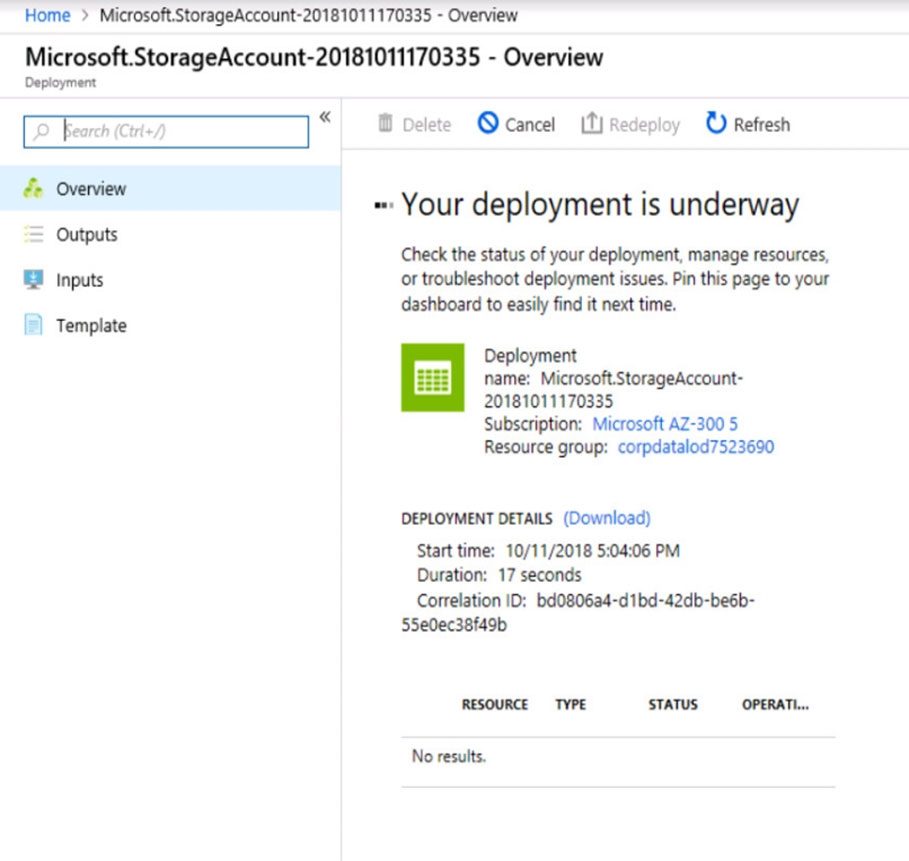
When you are finished performing all the tasks, click the `˜Next' button. Note that you cannot return to the lab once you click the `˜Next' button. Scoring occur in the background while you complete the rest of the exam. Overview - The following section of the exam is a lab. In this section, you will perform a set of tasks in a live environment. While most functionality will be available to you as it would be in a live environment, some functionality (e.g., copy and paste, ability to navigate to external websites) will not be possible by design. Scoring is based on the outcome of performing the tasks stated in the lab. In other words, it doesn't matter how you accomplish the task, if you successfully perform it, you will earn credit for that task. Labs are not timed separately, and this exam may have more than one lab that you must complete. You can use as much time as you would like to complete each lab. But, you should manage your time appropriately to ensure that you are able to complete the lab(s) and all other sections of the exam in the time provided. Please note that once you submit your work by clicking the Next button within a lab, you will NOT be able to return to the lab. To start the lab - You may start the lab by clicking the Next button. You plan to back up all the Azure virtual machines in your Azure subscription at 02:00 Coordinated Universal Time (UTC) daily. You need to prepare the Azure environment to ensure that any new virtual machines can be configured quickly for backup. The solution must ensure that all the daily backups performed at 02:00 UTC are stored for only 90 days. What should you do from your Recovery Services vault on the Azure portal?
HOTSPOT - You have an Azure subscription named Subscription1. Subscription1 contains the virtual machines in the following table.Subscription1 contains a virtual network named VNet1 that has the subnets in the following table.
VM3 has a network adapter named NIC3. IP forwarding is enabled on NIC3. Routing is enabled on VM3. You create a route table named RT1 that contains the routes in the following table.
You apply RT1 to Subnet1 and Subnet2. For each of the following statements, select Yes if the statement is true. Otherwise, select No. NOTE: Each correct selection is worth one point. Hot Area:
HOTSPOT - You have a virtual network named VNet1 that has the configuration shown in the following exhibit.Use the drop-down menus to select the answer choice that completes each statement based on the information presented in the graphic. NOTE: Each correct selection is worth one point. Hot Area:
You create an Azure Kubernetes Service (AKS) cluster and an Azure Container Registry. You need to perform continuous deployments of a containerized application to the AKS cluster as soon as the image updates in the registry. What should you use to perform the deployments?
A. an Azure Automation runbook
B. a kubectl script from a CRON job
C. an Azure Resource Manager template
D. an Azure Pipelines release pipeline
Your network contains an on-premises Active Directory domain named contoso.com that contains a member server named Server1. You have the accounts shown in the following table.You are installing Azure AD Connect on Server1. You need to specify the account for Azure AD Connect synchronization. The solution must use the principle of least privilege. Which account should you specify?
A. CONTOSOUser2
B. SERVER1User4
C. CONTOSOUser1
D. CONTOSOUser3
HOTSPOT - You plan to create a virtual machine as shown in the following exhibit.Use the drop-down menus to select the answer choice that completes each statement based on the information presented in the graphic. NOTE: Each correct selection is worth one point. Hot Area:
You have an Azure Container Registry and an Azure container instance. You pull an image from the registry, and then update the local copy of the image. You need to ensure that the updated image can be deployed to the container instance. The solution must ensure that you can deploy the updated image or the previous version of the image. What should you do?
A. Run the docker image push command and specify the tag parameter.
B. Run the az image copy command and specify the tag parameter.
C. Run the az aks update command and specify the attach-acr parameter.
D. Run the kubectl apply command and specify the dry-run parameter.
HOTSPOT - You have several Azure virtual machines on a virtual network named VNet1. VNet1 has two subnets that have 10.2.0.0/24 and 10.2.9.0/24 address spaces. You configure an Azure Storage account as shown in the following exhibit.Use the drop-down menus to select the answer choice that completes each statement based on the information presented in the graphic. NOTE: Each correct selection is worth one point. Hot Area:
You have a web app named WebApp1 that uses an Azure App Service plan named Plan1. Plan1 uses the D1 pricing tier and has an instance count of 1. You need to ensure that all connections to WebApp1 use HTTPS. What should you do first?
A. Scale up Plan1.
B. Modify the connection strings for WebApp1.
C. Scale out Plan1.
D. Disable anonymous access to WebApp1.
You have an Azure subscription that contains a resource group named RG1. RG1 contains multiple resources. You need to trigger an alert when the resources in RG1 consume $1,000 USD. What should you do?
A. From Cost Management + Billing, add a cloud connector.
B. From the subscription, create an event subscription.
C. From Cost Management + Billing, create a budget.
D. From RG1, create an event subscription.
You have an Azure subscription named Subscription1 that is used by several departments at your company. Subscription1 contains the resources in the following table.Another administrator deploys a virtual machine named VM1 and an Azure Storage account named Storage2 by using a single Azure Resource Manager template. You need to view the template used for the deployment. From the Azure Portal, for which blade can you view the template that was used for the deployment?
A. Container1
B. VM1
C. Storage2
D. RG1
You plan to automate the deployment of a virtual machine scale set that uses the Windows Server 2016 Datacenter image. You need to ensure that when the scale set virtual machines are provisioned, they have web server components installed. Which two actions should you perform? Each correct answer presents part of the solution. NOTE: Each correct selection is worth one point.
A. Upload a configuration script.
B. Create an automation account.
C. Create a new virtual machine scale set in the Azure portal.
D. Create an Azure policy.
E. Modify the extensionProfile section of the Azure Resource Manager template.
SIMULATION - Click to expand each objective. To connect to the Azure portal, type https://portal.azure.com in the browser address bar.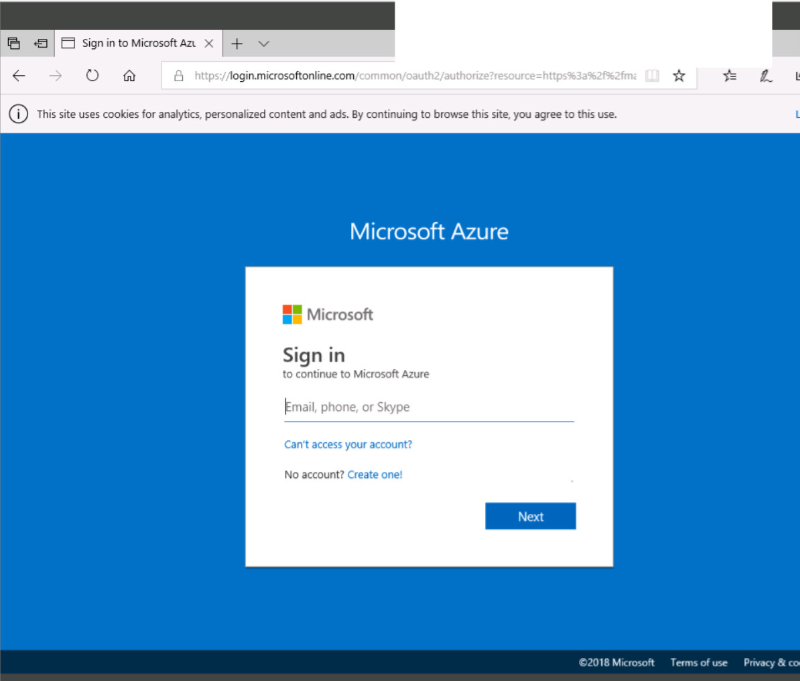
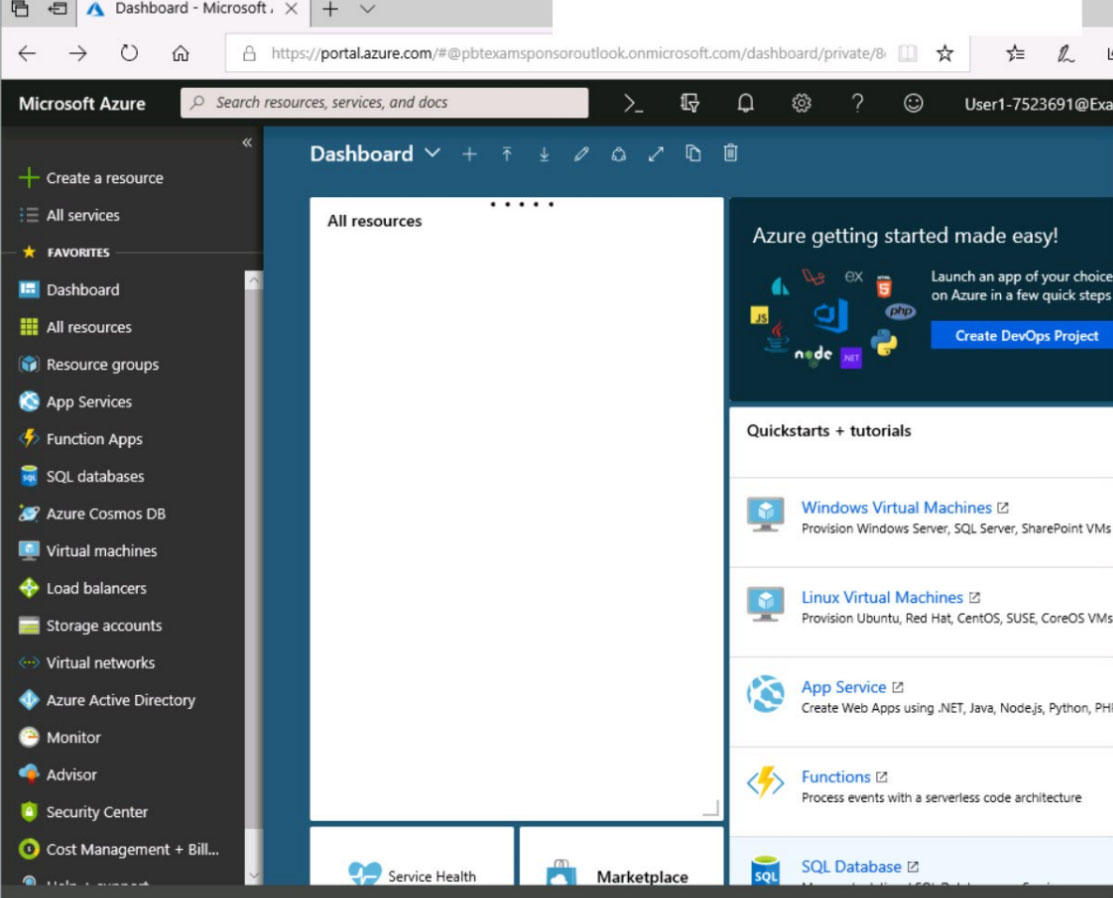
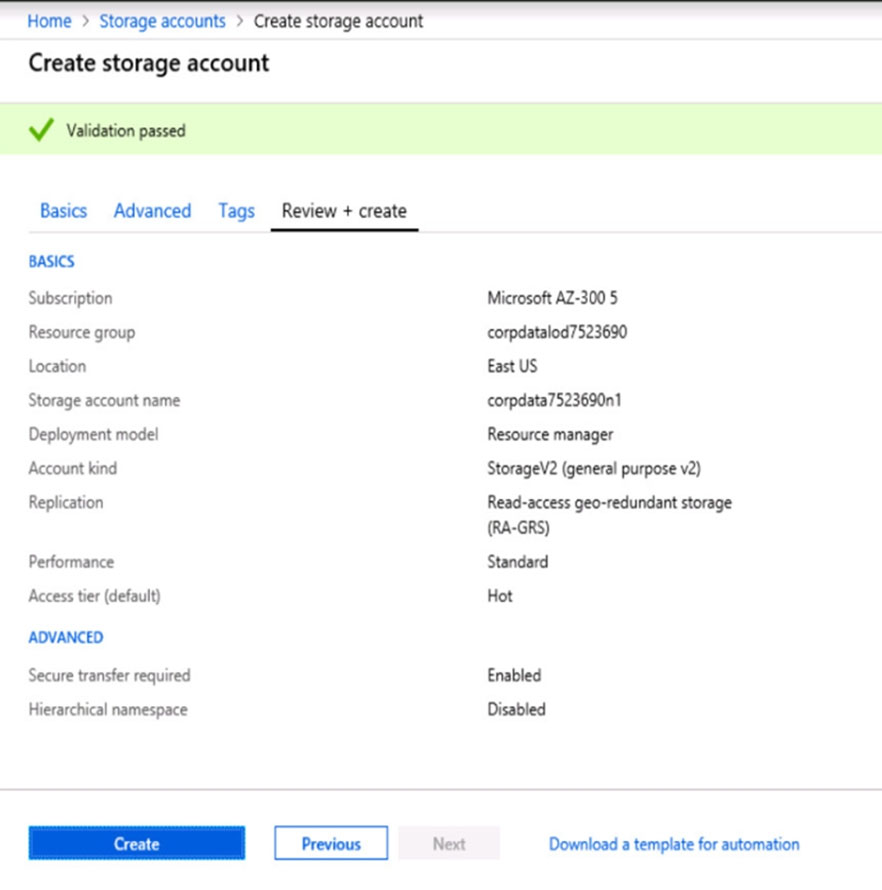
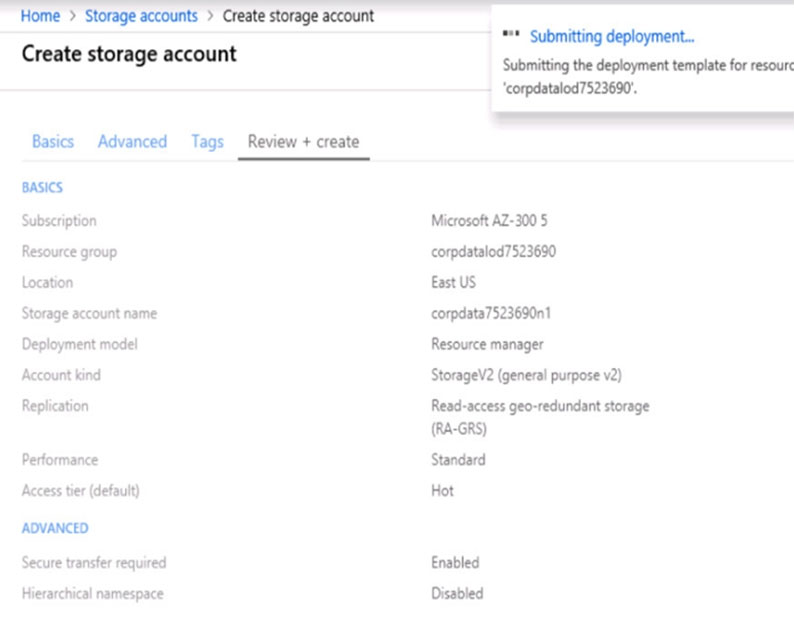
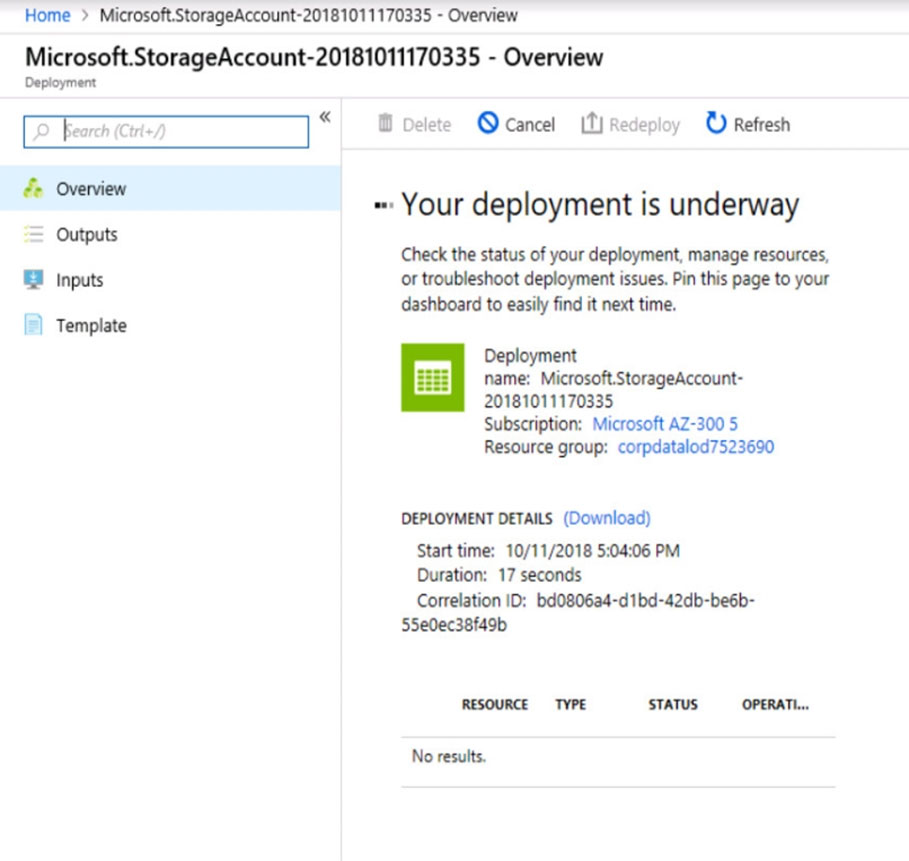
When you are finished performing all the tasks, click the `˜Next' button. Note that you cannot return to the lab once you click the `˜Next' button. Scoring occur in the background while you complete the rest of the exam. Overview - The following section of the exam is a lab. In this section, you will perform a set of tasks in a live environment. While most functionality will be available to you as it would be in a live environment, some functionality (e.g., copy and paste, ability to navigate to external websites) will not be possible by design. Scoring is based on the outcome of performing the tasks stated in the lab. In other words, it doesn't matter how you accomplish the task, if you successfully perform it, you will earn credit for that task. Labs are not timed separately, and this exam may have more than one lab that you must complete. You can use as much time as you would like to complete each lab. But, you should manage your time appropriately to ensure that you are able to complete the lab(s) and all other sections of the exam in the time provided. Please note that once you submit your work by clicking the Next button within a lab, you will NOT be able to return to the lab. To start the lab - You may start the lab by clicking the Next button. You plan to connect several virtual machines to the VNET01-USEA2 virtual network. In the corpdatalod7523690 resource group, you need to create a virtual machine that uses the Standard_B2ms size named Web01 that runs Windows Server 2016. Web01 must be added to an availability set. What should you do from the Azure portal?
Note: This question is part of series of questions that present the same scenario. Each question in the series contains a unique solution that might meet the stated goals. Some question sets might have more than one correct solution, while others might not have a correct solution. After you answer a question in this section, you will NOT be able to return to it. As a result, these questions will not appear in the review screen. You have an Azure subscription. You have an on-premises file server named Server1 that runs Windows Server 2019. You manage Server1 by using Windows Admin Center. You need to ensure that if Server1 fails, you can recover the data from Azure. Solution: From the Azure portal, you create a Recovery Services vault. On VM1, you install the Azure Backup agent and you schedule a backup. Does this meet the goal?
A. Yes
B. No
You need to move the blueprint files to Azure. What should you do?
A. Use the Azure Import/Export service.
B. Use Azure Storage Explorer to copy the files.
C. Generate a shared access signature (SAS). Map a drive, and then copy the files by using File Explorer.
D. Generate an access key. Map a drive, and then copy the files by using File Explorer.
HOTSPOT - You have an Azure Resource Manager template for a virtual machine named Template1. Template1 has the following parameters section.For each of the following statements, select Yes if the statement is true. Otherwise, select No. NOTE: Each correct selection is worth one point. Hot Area:
You have an Azure subscription that contains 10 virtual machines on a virtual network. You need to create a graph visualization to display the traffic flow between the virtual machines. What should you do from Azure Monitor?
A. From Activity log, use quick insights.
B. From Metrics, create a chart.
C. From Logs, create a new query.
D. From Workbooks, create a workbook.
Note: This question is part of series of questions that present the same scenario. Each question in the series contains a unique solution that might meet the stated goals. Some question sets might have more than one correct solution, while others might not have a correct solution. After you answer a question in this section, you will NOT be able to return to it. As a result, these questions will not appear in the review screen. You have an Azure subscription named Subscription1. Subscription1 contains a resource group named RG1. RG1 contains resources that were deployed by using templates. You need to view the date and time when the resources were created in RG1. Solution: From the Subscription blade, you select the subscription, and then click Resource providers. Does this meet the goal?
A. Yes
B. No
HOTSPOT - You have Azure Storage accounts as shown in the following exhibit.Use the drop-down menus to select the answer choice that completes each statement based on the information presented in the graphic. NOTE: Each correct selection is worth one point. Hot Area:
SIMULATION - Click to expand each objective. To connect to the Azure portal, type https://portal.azure.com in the browser address bar.

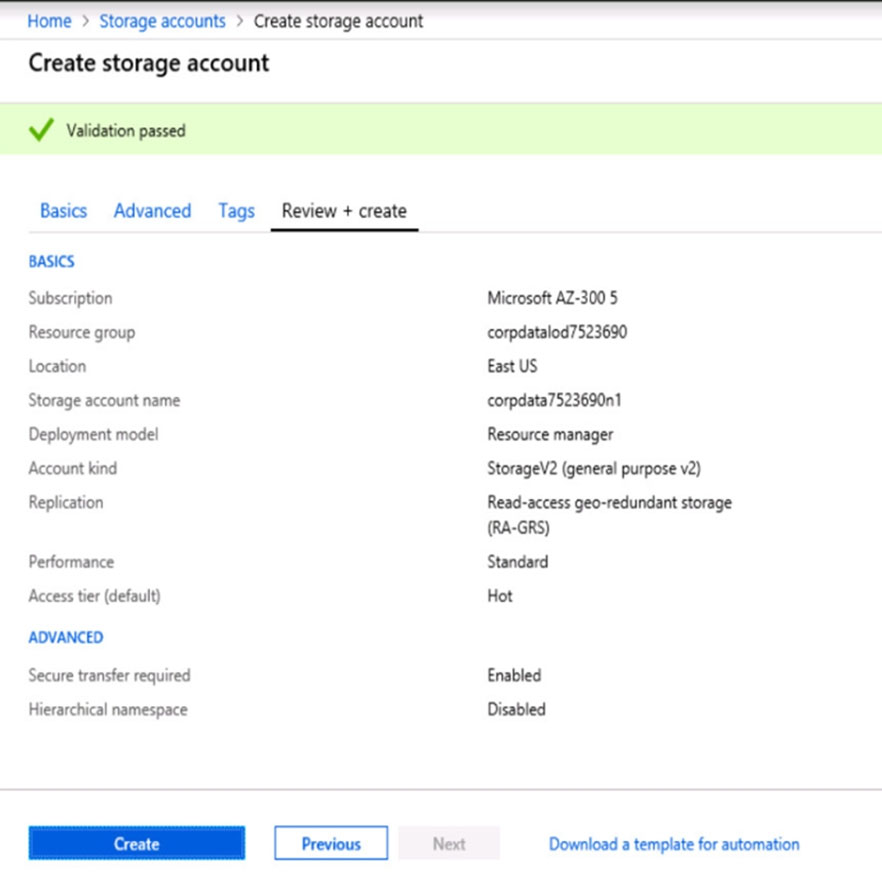
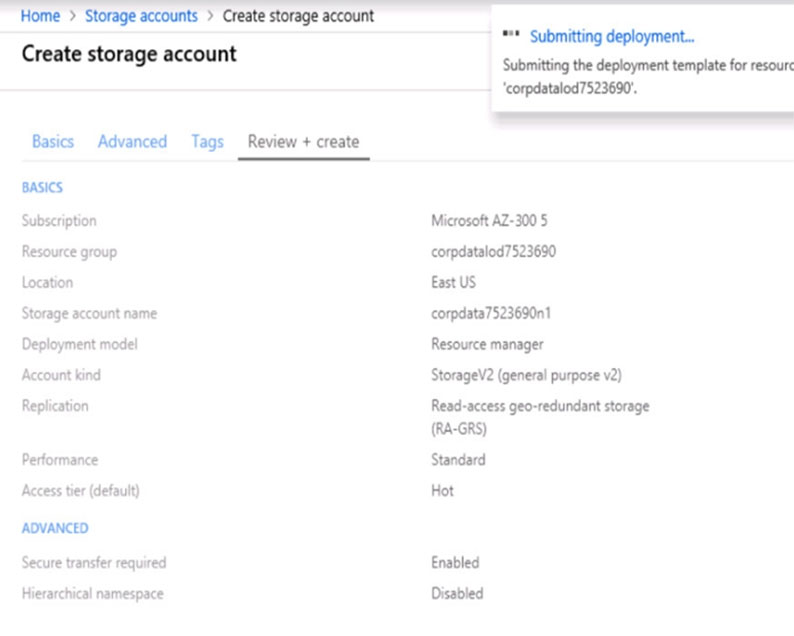
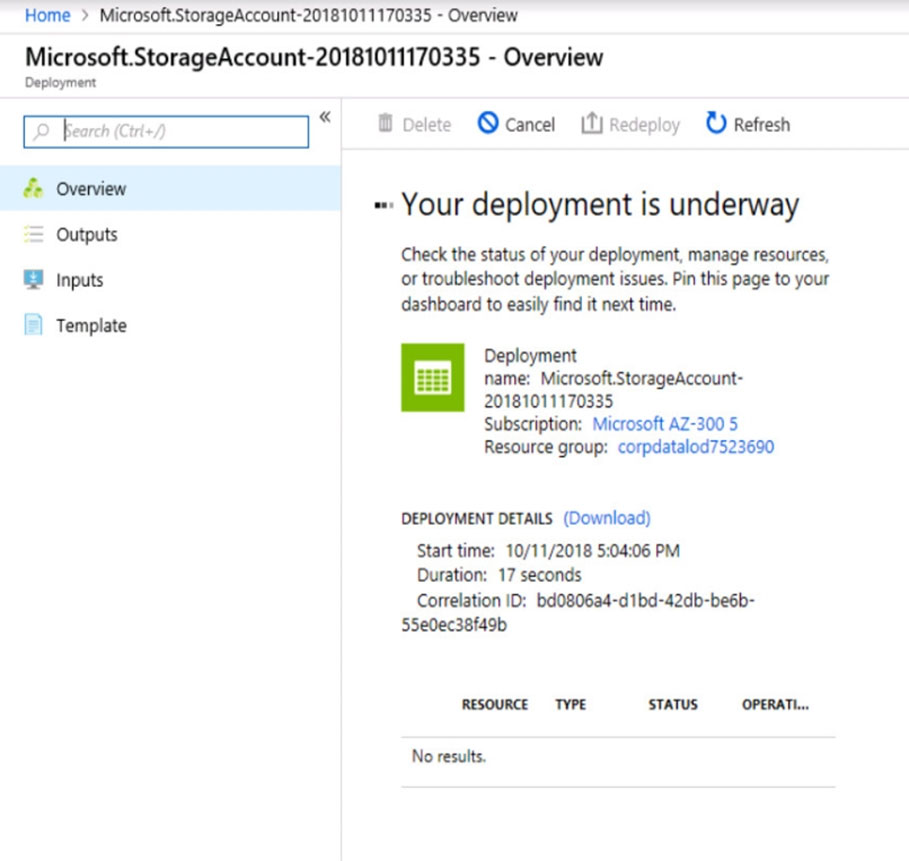
When you are finished performing all the tasks, click the `˜Next' button. Note that you cannot return to the lab once you click the `˜Next' button. Scoring occur in the background while you complete the rest of the exam. Overview - The following section of the exam is a lab. In this section, you will perform a set of tasks in a live environment. While most functionality will be available to you as it would be in a live environment, some functionality (e.g., copy and paste, ability to navigate to external websites) will not be possible by design. Scoring is based on the outcome of performing the tasks stated in the lab. In other words, it doesn't matter how you accomplish the task, if you successfully perform it, you will earn credit for that task. Labs are not timed separately, and this exam may have more than one lab that you must complete. You can use as much time as you would like to complete each lab. But, you should manage your time appropriately to ensure that you are able to complete the lab(s) and all other sections of the exam in the time provided. Please note that once you submit your work by clicking the Next button within a lab, you will NOT be able to return to the lab. To start the lab - You may start the lab by clicking the Next button. You recently created a virtual machine named Web01. You need to attach a new 80-GB standard data disk named Web01-Disk1 to Web01. What should you do from the Azure portal?
You have several Azure web apps that use access keys to access databases. You plan to migrate the access keys to Azure Key Vault. Each app must authenticate by using Azure Active Directory (Azure AD) to gain access to the access keys. What should you create in Azure to ensure that the apps can access the access keys?
A. managed identities
B. managed applications
C. Azure policies
D. an App Service plan
DRAG DROP - You have an on-premises file server named Server1 that runs Windows Server 2016. You have an Azure subscription that contains an Azure file share. You deploy an Azure File Sync Storage Sync Service, and you create a sync group. You need to synchronize files from Server1 to Azure. Which three actions should you perform in sequence? To answer, move the appropriate actions from the list of actions to the answer area and arrange them in the correct order. Select and Place:
After you answer a question in this section, you will NOT be able to return to it. As a result, these questions will not appear in the review screen. You manage an Active Directory domain named contoso.local. You install Azure AD Connect and connect to an Azure Active Directory (Azure AD) tenant named contoso.com without syncing any accounts. You need to ensure that only users who have a UPN suffix of contoso.com in the contoso.local domain sync to Azure AD. Solution: You use the Synchronization Service Manager to modify the Active Directory Domain Services (AD DS) Connector. Does this meet the goal?
A. Yes
B. No
You have an Azure subscription that contains the storage accounts shown in the following table.You enable Storage Advanced Threat Protection (ATP) for all the storage accounts. You need to identify which storage accounts will generate Storage ATP alerts. Which two storage accounts should you identify? Each correct answer presents part of the solution. NOTE: Each correct selection is worth one point.
A. storagecontoso1
B. storagecontoso2
C. storagecontoso3
D. storagecontoso4
E. storagecontoso5
You develop an entertainment application where users can buy and trade virtual real estate. The application must scale to support thousands of users. The current architecture includes five Azure virtual machines (VM) that connect to an Azure SQL Database for account information and Azure Table Storage for backend services. A user interacts with these components in the cloud at any given time. ✑ Routing Service `" Routes a request to the appropriate service and must not persist data across sessions. ✑ Account Service `" Stores and manages all account information and authentication and requires data to persist across sessions ✑ User Service `" Stores and manages all user information and requires data to persist across sessions. ✑ Housing Network Service `" Stores and manages the current real-estate economy and requires data to persist across sessions. ✑ Trade Service `" Stores and manages virtual trade between accounts and requires data to persist across sessions. Due to volatile user traffic, a microservices solution is selected for scale agility. You need to migrate to a distributed microservices solution on Azure Service Fabric. Solution: Deploy a Windows container to Azure Service Fabric for each component. Does the solution meet the goal?
A. Yes
B. No
You have an Azure virtual network that contains a subnet named Subnet1. Subnet1 contains 50 virtual machines. Twenty-five of the virtual machines are web servers and the other 25 are application servers. You need to filter traffic between the web servers and the application servers by using application security groups. Which additional resource should you provision?
A. Azure Firewall
B. a user-defined route
C. Azure Private Link
D. a network security group (NSG)
Free Access Full AZ-303 Practice Exam Free
Looking for additional practice? Click here to access a full set of AZ-303 practice exam free questions and continue building your skills across all exam domains.
Our question sets are updated regularly to ensure they stay aligned with the latest exam objectives—so be sure to visit often!
Good luck with your AZ-303 certification journey!


